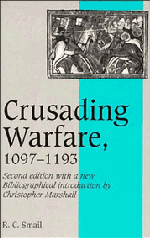Book contents
- Frontmatter
- Contents
- List of plates
- List of maps
- List of plans
- Preface (1954)
- List of abbreviations
- Bibliographical introduction (1994)
- I The historians of crusading warfare
- II Warfare and policy in Latin Syria
- III Franks, Armenians, and Syrians
- IV The Muslim armies
- V The Latin armies
- VI The Latin field army in action
- VII The Crusaders' castles
- Bibliography
- Bibliography to the second edition
- Index
- Plate section
VII - The Crusaders' castles
Published online by Cambridge University Press: 29 September 2009
- Frontmatter
- Contents
- List of plates
- List of maps
- List of plans
- Preface (1954)
- List of abbreviations
- Bibliographical introduction (1994)
- I The historians of crusading warfare
- II Warfare and policy in Latin Syria
- III Franks, Armenians, and Syrians
- IV The Muslim armies
- V The Latin armies
- VI The Latin field army in action
- VII The Crusaders' castles
- Bibliography
- Bibliography to the second edition
- Index
- Plate section
Summary
All governments are to some extent based on force, and it was perhaps the principal foundation of Frankish domination in Syria. Not only was the threat of invasion almost continuous, but many of the subject peoples never fully consented to Latin rule, and on important occasions were to show themselves either doubtfully loyal or actively hostile. That force was embodied in the twin instruments of the field army and the walled places, and of these the second is the subject of this chapter. In the first section their military functions will be discussed; in the second, their form.
THEIR MILITARY FUNCTIONS
The castles of Latin Syria had no more important military function than that which has just been stated, and which was discussed in an earlier chapter. Historians have nevertheless preferred to consider them mainly as means of defending a frontier, and they have done so in metaphorical phrases of no very precise meaning: they have said, for example, that a castle ‘guarded the frontier’ or ‘commanded the valley’ or ‘closed the route’. Since there have been epochs in which fortresses have, in time of war, literally discharged such functions, it must at once be emphasized that the medieval castle did so in only a limited sense.
- Type
- Chapter
- Information
- Crusading Warfare, 1097–1193 , pp. 204 - 250Publisher: Cambridge University PressPrint publication year: 1994

